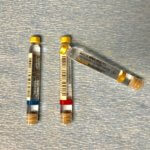Local anesthetic dosages. A new look at an old drug

That is incorrect.
Explanantion: A concentration of 1:100,000 epinephrine is a ratio. 1:100,000 represents 1 gram of epinephrine dissolved in 100,000 ml of solvent. This is equivalent to 10 mcg/ml (where mcg = micrograms).
To simplify the math, let's over estimate the volume at 2 cc per dental carpule rather than the peculiar dose of 1.7 or 1.8 cc. This is safe practice for estimating dosages.
Each dental carpule of anesthetic that has epinephrine in a 1:100,000 concentration has roughly 20 mcg of epinephrine per carpule. See below:
10 mcg/ml x 2.0 cc/carpule = 18 mcg/carpule
4 carpules x 20 mcg/carpule = 80 mcg of epinephrine.
There is no maximum dose of epinephrine recommended. However it is prudent to have a baseline blood pressure and monitor the blood pressure during the appointment. By way of comparison, the epinephrine dose for treatment of anaphylaxis is 300mcg.
To learn more and expand you knowledge check out Southwest Oral Surgery's new online Continuing Education course on local anesthetics and safe dosages by clicking the link below.
